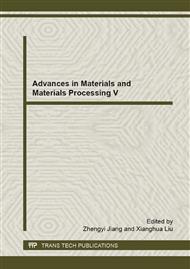p.267
p.276
p.280
p.287
p.291
p.295
p.299
p.304
p.309
Fabrication an Antibacterial Surface on Composite Porous Scaffold
Abstract:
Elimination of the residual microorganisms from an infectious bone defects and the prevention of subsequent re-infection are of importance for chronic osteomyelitis treatment. The application of bone repair materials with antibacterial properties in such a condition has advantages. The present study reported a novel method to fabricate nanohydroxyapatite/polyurethane (n-HA/PU) based antibacterial porous scaffolds through immobilization "core-shell" silver-based mesoporous silica particles (Ag@SiO2), i.e., silver nanoparticle as core and mesoporous silica as shell, on the surface of n-HA/PU scaffold. The samples were characterized by Scanning Electron Microscope (SEM) and antibacterial tests. The results revealed that the Ag@SiO2 nanoparticles distributed uniformly on the surface of n-HA/PU porous scaffold. The Ag@SiO2 could been kept on the surface of n-HA/PU porous scaffold more than 2 weeks, resulting in long-lasting the release of silver ions and antibacterial ability. The porous n-HA/PU scaffolds with an antibacterial surface may hold promise to be used in infectious bone defects repair.
Info:
Periodical:
Pages:
291-294
Citation:
Online since:
March 2015
Authors:
Keywords:
Price:
Сopyright:
© 2015 Trans Tech Publications Ltd. All Rights Reserved
Share:
Citation:


